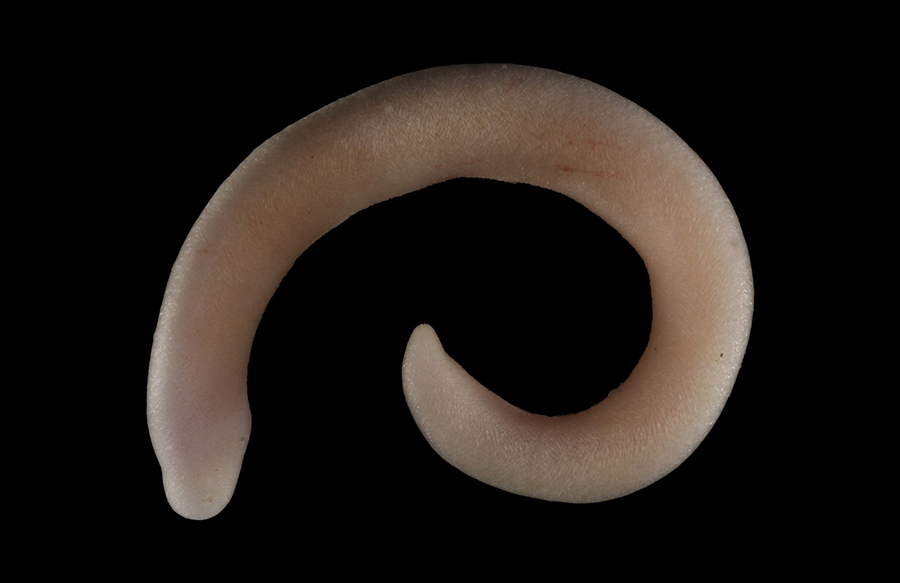Cruising for MollusksResearchers Sail Across the Planet Searching for Spiny Sparkly "Worms"Posted March 29, 2021
Scientists are going to the ends of the Earth to discover all they can about an obscure group of sparkly, worm-like mollusks. 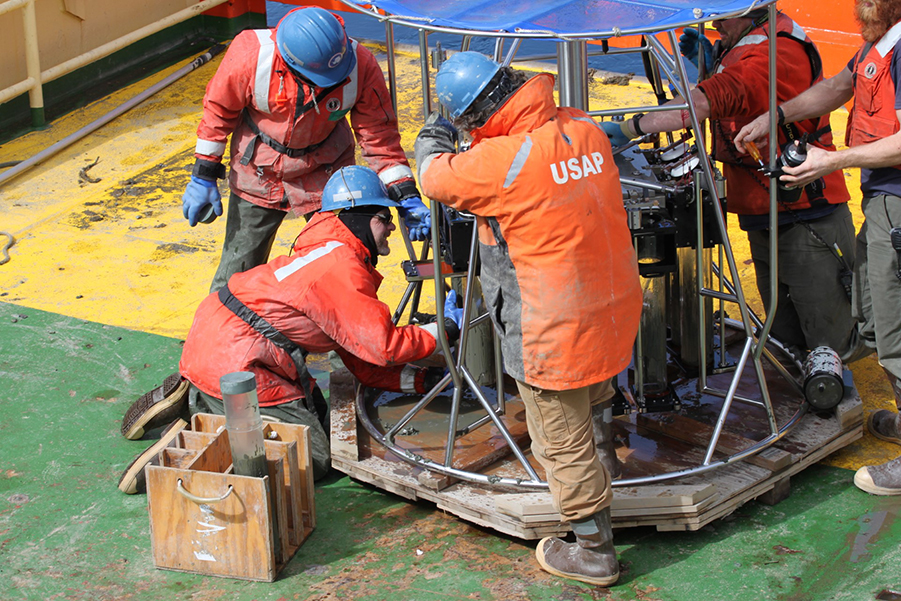
Photo Credit: Rebecca Varney
Scientists and marine technicians work to remove samples of mud from the "Megacorer," a device that collects a dozen samples of seabed sediment at a time.
There's lots of these critters living on the seafloor surrounding Antarctica, but they're not easy to get at and only a few scientists are studying them. In October, researchers sailed from California to Antarctica searching for aplacophorans, a diverse group of poorly understood distant sea slug cousins. "The Antarctic [region] is changing really quickly, including marine habitats," said Kevin Kocot, a zoologist at the University of Alabama, Tuscaloosa and principal investigator on the project. "We really need to know what's there to even know how climate change is affecting these communities. Right now we haven't even named many of these species." The research is supported by the National Science Foundation, which manages the U.S. Antarctic Program. Living Between Sand GrainsThe research team set sail to learn more about the aplacophorans that live in the frigid oceans surrounding Antarctica. The two classes of aplacophorans are an ancient branch of the mollusk tree that make their home on the seafloor. "Although individually they're tiny, there's zillions of them collectively, and they are really ecologically important to the Antarctic," Kocot said. Some species are relatively common while others can be quite difficult to find. A number are picky eaters and only feed on single species of coral or worm, while others are generalists and chow down on anything that comes their way. Collectively, they play a big role in stirring up and redistributing nutrients that fall to the ocean floor with sediments. 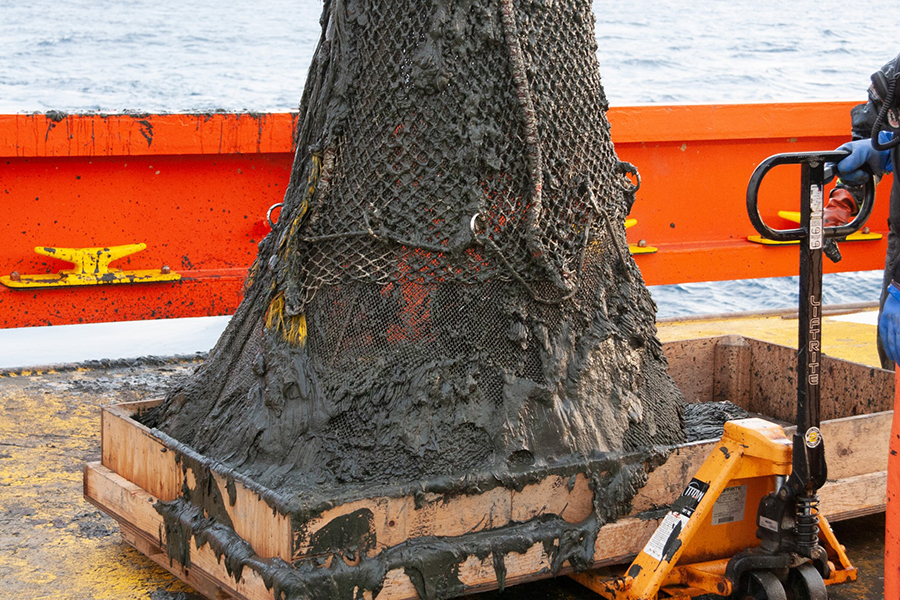
Photo Credit: Rebecca Varney
One of the trawls full of mud and sediment is lowered onto the deck of the Nathaniel B. Palmer so scientists can sift through and look for organisms buried within.
"Aplacophorans can be in any ocean anywhere in the world. They can be in the tropics down to the deep sea in Antarctica," Kocot said. "They can range from 40 cm in length… to less than a millimeter. They can be microscopic and basically between grains of sand." Antarctic seas are home to some of the species that grow the largest. Because the waters of the Southern Ocean are so cold and contain more dissolved oxygen, numerous marine creatures grow to gigantic sizes. It's a trait called polar gigantism and turned out to be helpful for the researchers learning to identify the different aplacophorans collected on the cruise. "Once you get to look at the big ones, then it's a lot easier to figure out what you're looking at at the small scales," said Rebecca Varney, a marine biologist at the University of Alabama, Tuscaloosa. Though they might look like worms, they're mollusks, a phylum distinct from the annelids which are the more familiar marine worms. "These things are related to snails, slugs, clams, squid and octopus, but they are called aplacophorans, which is Latin for ‘without a shell,'" Kocot said. "They're worm-like, shell-less mollusks and are actually really diverse in the Antarctic. Every time we go, we find new species. It can be really hard to identify them in the field because they often look kind of like little spiny worms and even under a microscope." Sparkly MollusksInstead of shells, these mollusks are covered in spines called sclerites made of calcium carbonate that stick out like quills on a hedgehog. "The sclerites are reflective. When the light hits them, the worms themselves literally sparkle," Varney said. "They are these tiny tube-shaped mollusks that sparkle." 
Photo Credit: Kevin Kocot
On the deck of the Nathaniel B. Palmer, Will Ballentine (left) and Ken Halanych sieve through a muddy sample during the brief Antarctic night looking for animals buried within.
This shiny appearance helps the team find the smallest critters hiding amongst the sediment they pull up from the ocean floor. Their tell-tale sparkle under a bright light is a giveaway that there's an aplacophoran tucked away between the grains of sand. These spines help the researchers identify the aplacophorans in other ways as well. "You can actually use them to tell them apart — some of the species," Varney said. "Some of the sclerites — these spines — can look totally different from one another. Some of them can look like leaf blades, some of them are hollow inside and some of them have these crazy weird hooks at the end." However, the variation in spines can only get them so far. "That's one problem that we face that there's a lot of cryptic species, things that look the same but really quite different," Kocot said. The team collected 160 samples, though they're not yet sure exactly how many species they might have. On the ship, they identified about 120 "morphospecies," different types that can be clearly identified just by looking at them, but it's conceivable that every sample is a different species. "There's not always a lot you can see on the outside," Varney said. "For a lot of the aplacophorans you have to go to internal anatomy to decide whether they are the same species or not." Once the samples reach Kocot's lab, he has a whole range of techniques to definitively identify each creature. One of the traditional methods is called histology, where researchers look at thin slices through the creature through a microscope and identify its internal structures. It's a slow, labor-intensive process, so Kocot is pushing ahead with more cutting-edge techniques. He's planning on using a special micro-CT scanner to take a three-dimensional x-ray of the creatures' insides. "Part of the reason why many people haven't gravitated towards this group to study, just from a taxonomic point of view, is that it's a lot of work," Kocot said. "We have to put a lot of work into that histology. Doing things like micro-CT scanning will speed up the pace of looking at those internal characteristics to identify these things." His lab will also be extracting DNA from the creatures, not only to help his team identify what they've collected, but to help future researchers identify their discoveries as well. 
Photo Credit: Kevin Kocot
In the lab on board the Nathaniel B. Palmer, the research team processes and preserves the samples they collected for later analysis.
"He's also producing what we call ‘DNA barcodes,'" Varney said. "As we get these samples home and we start getting DNA out of them, all of that DNA goes online. Then other scientists that find a specimen can just extract DNA, which we kind of all know how to do, and then ‘science-google' what is this animal?" Getting ThereEven under the best of circumstances, it's a long voyage to Antarctica. However, because of the COVID-19 pandemic, the research team set sail for the frozen continent from the continental United States, a first for the U.S. Antarctic Program. Ordinarily, teams of researchers would first fly to Punta Arenas, Chile, and meet in town or on the ship. The team left their homes on September 20 and arrived in San Francisco for their first round of quarantine. After three days isolated in a hotel and a negative COVID test, they boarded the research vessel Nathanial B. Palmer, for a two-week quarantine onboard the ship. During this time, the Palmer sailed south to Port Hueneme, California, to pick up supplies and moor in a secure harbor while the passengers finished their time in quarantine. After the two weeks had passed and no one was diagnosed with COVID-19, the ship set sail heading south again. After a lengthy, 25-day journey across the equator, it briefly pulled into port at Punta Arenas to pick up a few pieces of scientific equipment, then continued on to the Weddell Sea east of the Antarctic Peninsula. Though the extra time needed to safely transport the scientists and support staff down to Antarctica was a lot longer than a typical cruise, the researchers used the time well to get acquainted with boat operations and the different technicians working onboard. "We were on a boat together for three full months, so I got to know everyone really well," Varney said. "Getting to know all those people I think was such a benefit for the overall success of the cruise because they got to know us, they got to know what we really were hoping to get out of it on a deeper level… having the comfort and collegiality with all of the people on the boat really contributed to the success of the cruise." Working with the technicians on board, the team used a variety of tools to collect the animals from the ocean floor. Over the side of the boat, they dropped several different kinds of trawlers that scooped up sediment and sea creatures as it dragged along the seafloor. They also used devices that grabbed deep profiles of the seafloor, including the impressively-named "Megacorer." 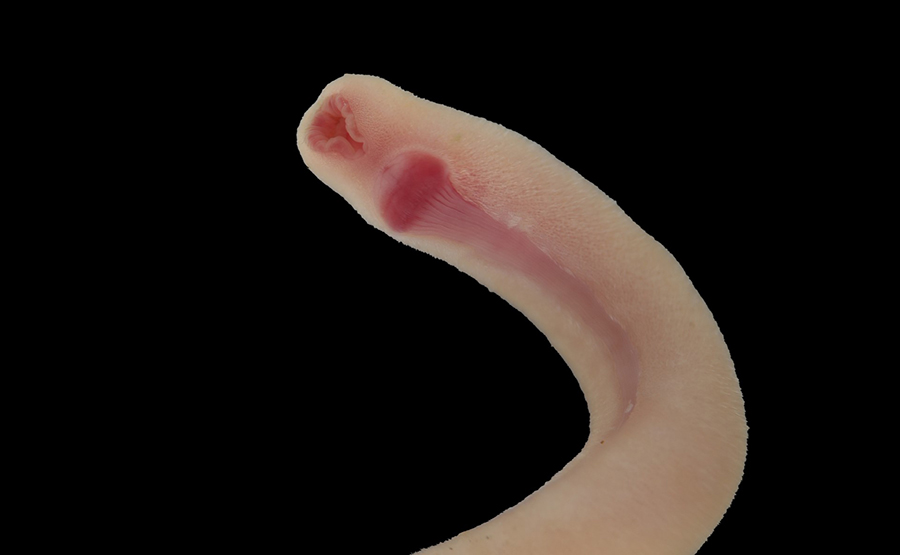
Photo Credit: Kevin Kocot
A close up of one of the Amphimeniidae, one of the worm-like aplacophorans collected by the team, shows its mouth and below that its "foot" used for moving around. Though hard to discern on the larger species aplacophorans are covered in tiny calcified spines.
"The Megacorer is basically a donut of 12 circular hole punches," Varney said. "It punches all 12 of them at the same time, so you get these deep, two-foot-long tubes that are nice profiles of the sediment from the water all the way down." Once the samples were on board, the team would scrutinize the marine sand and sediment, looking for the tell-tale sparkle of a burrowed aplacophoran. "We spent a lot of time at the microscope sifting through the material that we would be sieve out of a core or a trawl," Kocot said. They would identify what they could, and then image and preserve everything for shipment back to Kocot's lab for further identification. Teaching CruiseIn addition to learning about the aplacophorans themselves, teaching his team how to identify these mollusks was a big part of Kocot's project as well. "Taxonomy is a field that's really important to all other areas of biology," Kocot said. "We need to be able to identify organisms to study their conservation, diversity and whatnot. But there's a dearth of training for folks to even learn how to identify animals and many groups of organisms." His team was largely made up of students, with the aim of bringing them down to Antarctica to analyze and identify this relatively understudied group of mollusks. "It's really important to be training the next generation of experts on invertebrates and biodiversity in general," Kocot said. "I don't expect everyone in my lab to go on to be an expert on this one obscure group of worms that most people have never heard of, but I do want them to be expert zoologists and be able to be handed a weird organism and, using the skills they have, be able to identify it or recognize it as a species that is unknown to science." 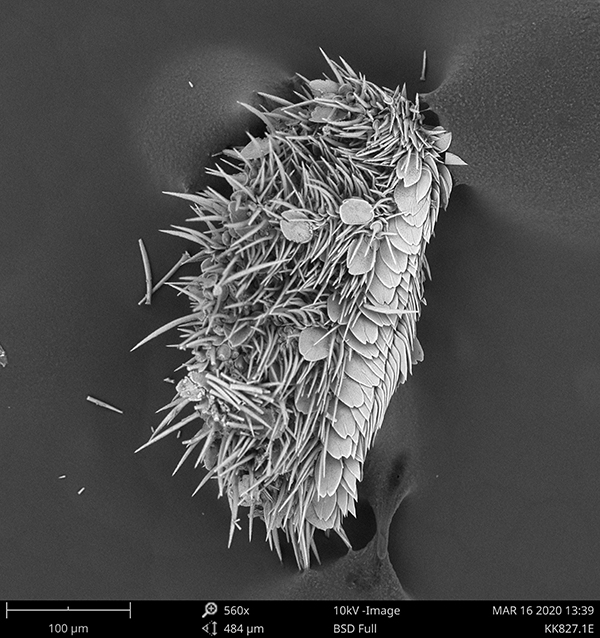
Photo Credit: Kevin Kocot
An electron-microscope image of a tiny aplacophoran, covered in tiny but pronounced calcified spines.
In addition, learning more about this understudied branch of mollusks could help trace the group's evolutionary history. "If we want to understand what kind of the ancestral proto-mollusk may have been like, we can't really ask that question based only on a clam and a snail and an octopus because then we're missing a big part of what it means to be a mollusk," Varney said. Not only will what they found likely help trace the ancient beginnings of aplacophorans, it might be able to help predict their future as well. "We have data that will probably end up informing studies of climate change. We have data that can inform understanding of animals everywhere, because these invertebrate groups are everywhere," Varney said. "Everything is connected, everything is important, and Antarctica is a place where we can do research that we cannot do anywhere else." Once all of the samples collected on the cruise arrive at his lab, Kocot and his team will have months if not years of identification work ahead of him. However, he's already looking forward to a return cruise to Antarctica scheduled for 2023. "I'm really excited about that one because we're going to East Antarctica," Kocot said. "U.S. ships very rarely make it over there, and there's really not a lot in museum collections of marine invertebrates from that region… I have a feeling we're going to be seeing a very different community and a lot of different species." NSF-funded research in this story: Kevin Kocot, University of Alabama Tuscaloosa, Award No. 1846174. |



For USAP Participants |
For The Public |
For Researchers and EducatorsContact UsNational Science FoundationOffice of Polar Programs Geosciences Directorate 2415 Eisenhower Avenue, Suite W7100 Alexandria, VA 22314 Sign up for the NSF Office of Polar Programs newsletter and events. Feedback Form |

